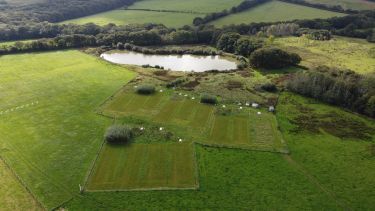Field site 2: North Wyke, Devon
Find out more about how we're researching greenhouse gas removal and other effects at our field site in North Wyke, Devon.

The Rothamsted Research North Wyke replicated lowland grazing plot facility is currently being used for dedicated ERW-GGR research. The facility comprises an outstanding experimental design for ERW research, with 6 replicated plots (10m × 34m) each fully hydrologically-isolated from the surrounding land, and each other, by French drains (these are 0.6m deep trenches lined with an impermeable plastic membrane, perforated drainage pipe, and backfilled to the surface with gravel) and inter-plot bunds to intercept lateral surface flow.
Intercepted runoff is piped to a collection pit for each plot, which is equipped with a thin-plate V-notch weir fitted with a capacitance sensor and data logger for measuring discharge at 1 minute intervals. This makes it very straight forward to sample waters for greenhouse gas (GHG) removal.
How are we working on the North Wyke field site?
In our first year of the project, work centres on establishing the grass plots with ryegrass and business-as-usual cross-compliance 2m wide grassy buffer strips above the drains. This is the minimum requirement and expectation of farmers to secure Pillar One payments pre- and post-Brexit, so is representative of how this type of farmland might be physically constructed in the current and near-future economic climate
We will robustly quantify GGR via ERW with annual crushed basalt application (40 tonnes per hectare) in years 2 to 4, and assess co-benefits for grassland production, soil health and GHG fluxes, for various combinations of standard practice inorganic (NPK) and organic (farmyard manure) fertilisers, with and without basalt dressing. The plots will be mown annually for silage with a grass harvester to accurately determine yields, so we can compare yields with and without basalt application.
How are we measuring results of greenhouse gas removal and other co-benefits at North Wyke?
Field sampling and laboratory analyses for determining the efficacy of ERW-GGR will comprise a comprehensive 3-year measurement programme.
- This will be via drainage water chemistry responses, soils, grass biomass elemental composition, and forage quality tests for digestability, including modified ash detergent.
- Soils will be sampled at 0-25 cm (i.e., plough layer) and 25-60 cm depths every 6 months (to establish a baseline to compare to after treatment) and analysed.
- Greenhouse gas fluxes (carbon dioxide, nitrous oxide and methane) will be monitored using 3 static chambers on each of the 6 replicate plots at daily to weekly to monthly intervals timed to capture fertilisation events over 3 years. The instrumentation and analysis is shared with Field Site 3 at Harpenden.
Environmental Risk Management
A large collection pond downslope of the facility mitigates water quality risks.
